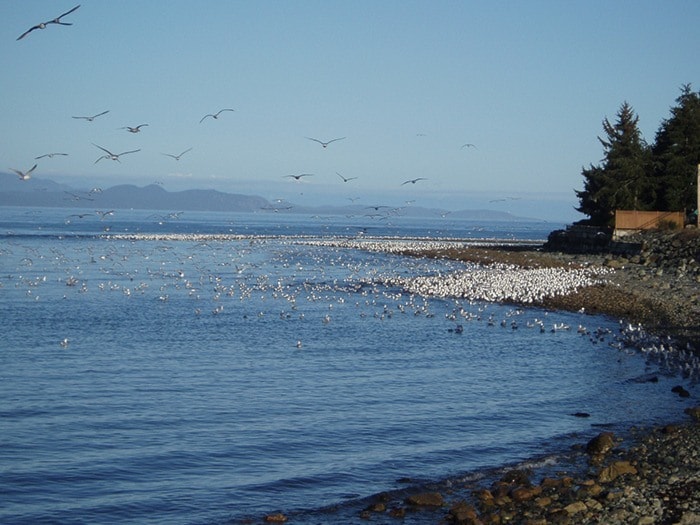Herring must be among the most prolific fishes on the planet. They are often referred to as the grass of the sea. Our local waters (management Area 14) are frequently the destinations and spawning grounds of billions of Pacific herring that make an annual migration from the Pacific Ocean off the west coast of Canada and the USA.
Since 1980 the seine fishery on roe herring has taken place at least 20 times in Baynes Sound. When it didn’t happen in the sound it was usually in the waters around Denman-Hornby islands and Cape Lazo. There was one brief abnormality when it occurred near Powell River in 1984 and 1987.
The seine fishery usually lasts one or two days – gillnet fishery is normally spread over several days and it takes place from Cape Lazo, Baynes Sound, Denman and Hornby islands to as far south as Nanaimo.
About the end of January the commercial fleet of seine and gillnet boats along with their support boats begin to assemble in our local ports and anchorages in anticipation of the coming spawning run of herring. One side affect is that it is good for local businesses that serve the needs of the fleet.
It is relatively easy to predict the anticipated run size for human beings with our modern systems of communication; but I wonder about the marvellous systems of nature that tell the birds, fish and animals that it is time to start gathering in Area 14 waters for the coming feasts of spawning herring.
Herring are targeted as food for other species at every level of development from freshly spawned eggs all the way through their entire life cycle. Birds gather to gulp down the fresh eggs and predatory fish and animals eat them at every stage of their life cycle. Humans eat them at all stages of development.
If you travel you can book trips to Africa to watch the great migrations of animals that occur across the landscape. I wonder how many people think of the great migrations of birds, animals and fish that are taking place in our local waters for the next couple of months?
If you live near the south end of Baynes Sound or within hearing distance of Norris Rocks and Flora Islets you know about the concentrations of sea lions that are happening right now. If those animals were subject to a noise bylaw they would all be in court.
There are hundreds of Steller and California sea lions hauled out on any place that meets their needs and they are more than a little vocal about their presence. We are used to seeing concentrations of swans that turn fields white. For the next couple of months do not be surprised if you witness a large beach that has suddenly turned white by huge concentrations of sea gulls that are resting after gorging on a nearby roe herring spawn event in shallow tidal waters.
Mixed with the confusion of a spawning act you will see large numbers of bald eagles joining the feast. There will also be a concentration of cormorants and various diving ducks. Below the surface we can only guess at the numbers of salmon and other predatory fish, dolphins, orcas and larger whales that come to take get their share of the bounty.
You get to witness a feast as well as a renewal of life as the waters turn white from the excess male sperms for the freshly spawned eggs of the females. To get a feel for the magnitude of Pacific herring spawning events you may be fortunate enough to see a beach that is covered by billions of tiny eggs up to a depth of several inches.
The Department of Fisheries and Oceans Canada (DFO) monitors the allowable catch based on information from the Centre for Scientific Advice – Pacific (CSAP). As I understand it, the target harvest for the Strait of Georgia is 20 per cent of the stock assessment.
In round figures, tonnage for the major roe herring fisheries are as follows: seines 7,543 tons, gillnet 6,090 tons, and winter food and bait 8,000 tons. The total planned harvest for all user groups is over 22,000 short tons. Our bait needs are a small part of the special use groups.
(Reference – DFO Commercial Fishing Plan for Roe herring – 2013/2014 season).
Ralph Shaw is a master fly fisherman who was awarded the Order of Canada in 1984 for his conservation efforts. In 20 years of writing a column in the Comox Valley Record it has won several awards.
